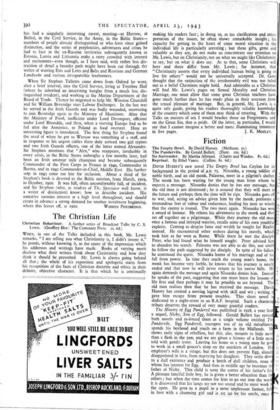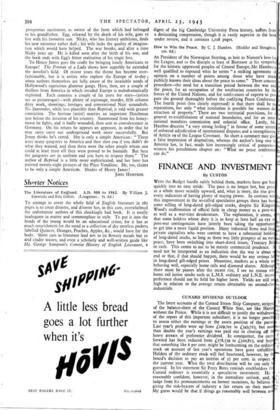Fiction
The Empty Bowl. By David Hussey. (Methuen. 5s.) The Pandervils. By Gerald Bullett. (Dent. los. 6d.) No Surrender. By Martha Albrand. (Chatto and Windus. 8s. 6d.) Reprisal. By Ethel Vance. (Collins. 8s. 6d.)
DAVID HUSSEY'S new novel The Empty Bowl has Ceylon for its background in the period of A.D. 75. Nissanka, a young soldier of noble birth, and an old monk, Palasena, meet in a pilgrim's shelter. The monk has been waiting for the young man from whom he expects a message. Nissanka denies that he has any message, but the old man is not distressed ; he is assured that they will meet in the future and perhaps then the time will be ripe. Nissanka goes off to war, and, acting on advice given him by the monk, performs a tremendous feat of valour and endurance, leading his men so wisely that the enemy is routed. The two meet again. Nissanka has won a sword of honour. He relates his adventures to the monk and they set off together on a pilgrimage. While they journey the old man once a famous and intrepid warrior, recalls some of his own youthful exploits. Coming to despise fame and wealth he sought for Reality instead. He encountered other seekers during his travels, which took him as far west as Rome. While there he met the disciple Peter, who had found what he himself sought. Peter advised him to abandon his search. Palasena was not able to do this, nor could he follow the path suggested by the disciple. In spite of his failure he continued the quest. Nissanka learns of his marriage and of his fall from power. In time they reach the young man's home, the monk has become very feeble, he knows that his journey is nearly ended and that now he will never return to his native hills. He again demands the message and again Nissanka denies him. Instead
he speaks of the past, suggesting that one must learn the lessons of life first and then perhaps it may be possible to see beyond. The old man realises then that he has received the message. David Hussey has created a moving legend with skill and wit ; writing it gave him escape from present troubles. This short novel is dedicated to a night-sister in an R.A.F. hospital. Such a charmin' tribute deserves the reward of very many grateful readers.
The History of Egg Pandervil was published in 1928, a year late a sequel, Nicky, Son of Egg, followed. Gerald Bullett has revised both novels and re-issued them as a single volume entitled Th Pcmdervils. Egg Pandervil, youngest son of an old mesallianc
spends his boyhood and youth on a farm in the Midlands. H shows early signs of rebellion, but this, alas, mounts to little mot than a flash in the pan, and we are given a history of a little ma told with gentle irony. Leaving his home as a young man he gt to work in a small grocer's shop on the outskirts of London. Ili employer's wife is a virago, but this does not prevent Egg, alread disappointed in love, from marrying her daughter. They settle den; to a dull existence and produce a batch of dull children, none whom has interest for Egg. And then in middle age he becomes th father of Nicky. This child is soon the centre of his father's lif A pleasant fanciful little boy, he is given a better education than t others ; but when the time comes for him to go out into the wor it is discovered that his lungs are not too sound and he must work the open. He goes as a pupil to a most unpleasant farmer, fall in love with a charming girl and is set up by his uncle, once
prosperous auctioneer, as owner of the farm which had belonged to his grandfather. Egg, released by the death of his wife, goes to live with his favourite son. Nicky, who has literary ambitions, finds his new existence rather dull ; his wife lacks the quality of imagina- tion which would have helped. The war breaks, and after a time Nicky joins up. He is killed soon after the birth of his son, and the book ends with Egg's bitter realisation of his tragic loss.
To Henry James goes the credit for bringing lonely Americans to Europe! The Portrait of a Lady shows how superbly he extended the novelist's field. Of recent years the theme has become over- fashionable, but it is artists who explore the Europe of to-day ; when authors themselves are fully aware of the insatiable needs of Hollywood's capricious glamour gangs. Here, then, are a couple of thrillers from America in which invaded Europe is melodramatically exploited. Each contains a couple of fat parts for stars—(artists are so picturesque)—with plenty of espionage, murder, fifth column dirty work, shootings, hostages and conventional Nazi scoundrels. No Surrender, while less plausible than Reprisal, is told with greater conviction. The heroine (artist) marries an important Dutchman just before the invasion of his country. Summoned from his honey- moon he fights, and is badly wounded, then sent to convalescence in Germany. On his return he appears an appeaser, in order that he may carry carry out underground work more successfully. But Jenny thinks he's ratted. She is only a simple American: "There were many gangsters in America and they shot you if you didn't do what they wanted, and then there were the other people whom one could at least trust till they were proved to be bastards. But here the gangsters are in uniform and you have to respect them." The author of Reprisal is a little more sophisticated, and her hero has painted twenty-eight pictures of the Place 'Vendome. He, too, claims to be only a simple American. Shades of Henry James!
JOHN HAMPSON.



























 Previous page
Previous page